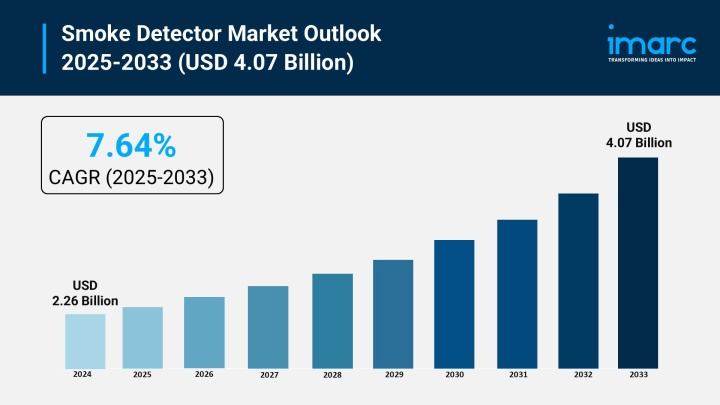

Market Overview:
The smoke detector market is experiencing rapid growth, driven by mandatory installation and stringent building codes, increasing integration with smart home ecosystems, and rapid urbanization and construction boom. According to IMARC Group’s latest research publication, “Smoke Detector Market Size, Share, Trends and Forecast by Product Type, Power Source, End-Use Sector, and Region, 2025-2033”, The global smoke detector market size was valued at USD 2.26 Billion in 2024. Looking forward, IMARC Group estimates the market to reach USD 4.07 Billion by 2033, exhibiting a CAGR of 7.64% from 2025-2033.
This detailed analysis primarily encompasses industry size, business trends, market share, key growth factors, and regional forecasts. The report offers a comprehensive overview and integrates research findings, market assessments, and data from different sources. It also includes pivotal market dynamics like drivers and challenges, while also highlighting growth opportunities, financial insights, technological improvements, emerging trends, and innovations. Besides this, the report provides regional market evaluation, along with a competitive landscape analysis.
Download a sample PDF of this report: https://www.imarcgroup.com/smoke-detector-market/requestsample
Our report includes:
Growth Factors in the Smoke Detector Market
The most significant driver for the global smoke detector market is the proliferation of stringent government safety regulations and mandatory building codes that require the installation of fire detection systems in residential, commercial, and industrial properties. In North America, which currently accounts for the largest share of the global market—over 30% of the total revenue—these regulations are particularly rigorous, often requiring hard-wired detectors with battery backups. Similar stringent mandates are being enforced across major European and Asia-Pacific economies, compelling compliance for new construction and renovations. This legislative pressure is a powerful, non-negotiable force compelling adoption across all sectors, ensuring a continuous baseline demand for both basic and advanced detection systems. The threat of substantial fines for non-compliance acts as a strong incentive for property owners and developers to adhere to these expanding fire safety rules.
The rapid adoption of smart home technology and the Internet of Things (IoT) is a powerful growth factor, transforming smoke detectors from simple warning devices into integrated safety components. This trend is particularly driving the faster growth of smart, IoT-enabled models, which are projected to grow significantly more quickly than conventional, stand-alone detectors. Leading companies like Google with its Nest Protect and numerous others offer products that seamlessly connect via Wi-Fi or other wireless protocols to a central smart home hub or mobile application. This integration allows for features such as remote monitoring, real-time alerts sent to a user's phone regardless of location, and automated actions like turning off the HVAC system during an emergency. This enhanced convenience and functionality appeal directly to the modern consumer, moving smoke detectors beyond mere compliance and into the realm of premium, user-friendly security solutions.
Accelerated urbanization, particularly in emerging markets across the Asia-Pacific region, is leading to a massive surge in residential and commercial construction activities, directly correlating to a heightened demand for fire safety equipment. The Asia-Pacific region is currently projected to be the fastest-growing market, demonstrating the impact of this infrastructure development. As older, standalone dwellings are replaced by multi-story buildings and apartment complexes, new safety requirements dictate the installation of interconnected and more sophisticated fire alarm systems. For instance, the sheer volume of new residential units being built annually across major economies translates into millions of new mandated installations, driving the market size. This construction activity creates a continual, high-volume requirement for fire safety solutions that meet both international and evolving local building standards.
Key Trends in the Smoke Detector Market
A major trend is the market's shift toward dual-sensor and multi-criteria smoke detectors which combine different detection technologies, such as photoelectric and ionization, or integrate smoke, heat, and carbon monoxide sensing into one unit. This development addresses the critical industry challenge of reducing false alarms while ensuring comprehensive fire detection capabilities for various fire types. Photoelectric sensors are highly effective at detecting slow, smoldering fires, while ionization sensors respond quickly to fast, flaming fires. The combination in dual-sensor units provides a more holistic and reliable response, making them increasingly mandated in updated building codes. This enhanced reliability directly improves consumer confidence and is leading to a strong preference for these advanced products in both commercial and residential sectors.
The integration of Artificial Intelligence (AI) and Machine Learning (ML) algorithms is emerging as a critical trend to significantly improve the reliability of fire detection systems and minimize frustrating false alarms. AI-powered detectors continuously analyze ambient data—including minute changes in air quality, temperature, and particulate signatures—to differentiate between actual fire smoke and benign sources like cooking fumes, steam, or dust. Companies are actively investing in research to train these models on massive datasets of environmental readings. This capability allows the detector to 'learn' its environment over time, resulting in a much lower incidence of false positives, which has historically been a major user pain point. The enhanced accuracy and reduced disruption provided by this intelligent analysis are pivotal for driving long-term adoption and user satisfaction.
The move towards wireless interconnected smoke detector systems is gaining significant traction, particularly in existing buildings and residential retrofits where running new wires is impractical or costly. These systems use radio frequency signals (like Wi-Fi, Bluetooth, or Z-Wave) to link all detectors in a building. When one alarm is triggered, all other units sound simultaneously, providing the earliest possible warning to everyone on the property. This trend is appealing to both homeowners and businesses for its ease of installation—often a simple DIY process—and its compliance with regulations that increasingly require alarms in one room to trigger alarms throughout the entire property. The convenience and enhanced safety coverage of these wireless systems are making them the preferred choice over older, standalone battery-operated models, driving strong growth in the wireless segment.
Leading Companies Operating in the Smoke Detector Industry:
Smoke Detector Market Report Segmentation:
By Product Type:
Photoelectric smoke detectors lead the market due to their effectiveness in detecting smoldering fires, lower false alarms, and compliance with strict safety regulations.
By Power Source:
Battery-powered detectors dominate for their ease of installation, no wiring requirements, and improved battery life, making them ideal for both new and retrofit applications.
By End-Use Sector:
The commercial sector holds the largest share, driven by mandatory fire safety systems, infrastructure growth, and businesses prioritizing employee and asset protection.
Regional Insights:
North America leads due to high adoption rates, strict NFPA regulations, rising CO awareness, commercial expansion, and strong smart home integration.
Note: If you require specific details, data, or insights that are not currently included in the scope of this report, we are happy to accommodate your request. As part of our customization service, we will gather and provide the additional information you need, tailored to your specific requirements. Please let us know your exact needs, and we will ensure the report is updated accordingly to meet your expectations.
About Us:
IMARC Group is a global management consulting firm that helps the world’s most ambitious changemakers to create a lasting impact. The company provide a comprehensive suite of market entry and expansion services. IMARC offerings include thorough market assessment, feasibility studies, company incorporation assistance, factory setup support, regulatory approvals and licensing navigation, branding, marketing and sales strategies, competitive landscape and benchmarking analyses, pricing and cost research, and procurement research.
Contact Us:
IMARC Group
134 N 4th St. Brooklyn, NY 11249, USA
Email: sales@imarcgroup.com
Tel No:(D) +91 120 433 0800
United States: +1-201971-6302
